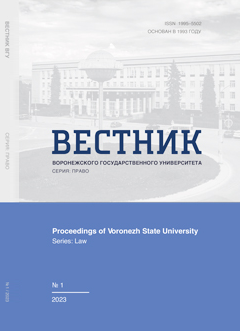Иерархический кластерный анализ паттернов поведения серийных насильственных преступников
Аннотация
В процессе развития в СССР/России учения о личности преступника и механизме его поведения в контексте действовавшей в то время идеологии возник ряд трудноразрешимых проблем и противоречий в сфере криминологических (криминально-антропологических) подходов к анализу паттернов поведения субъектов серийных насильственных преступлений. Предпринята попытка обобщить причины таких методологических нестыковок, а также на эмпирическом материале, представленном в базе данных Consolidated Serial Homicide Offender Database, с применением методов иерархического кластерного анализа описывается как структура элементов modus operandi, так и ряд нейропсихологических паттернов поведения серийных убийц. Одновременно в исследовании прослеживается связь между травматическими переживаниями, жестоким обращением с субъектом преступлений в детском возрасте и конкретным почерком совершения преступлений.
Скачивания
Литература
Brower M. C., Price B. H. Neuropsychiatry of frontal lobe dysfunction in violent and criminal behaviour: a critical review // Journal of Neurology, Neurosurgery & Psychiatry. 2001. Vol. 71, № 6. P. 720–726.
Canter D. Mapping murder: The secrets of geographical profi ling. Random House, 2007. 340 p.
C. H. d'E. L. “Criminal Sociology”. Charity Organization Review. 1896. Vol. 12, № 137. P. 247–252.
Douglas J., Burgess A. W., Burgess A. G., Ressler R. K. Crime Classifi cation Manual: A Standard System for Investigating and Classifying Violent Crime. 3rd ed. Hoboken, 2013. 557 p.
Douglas J. E., Munn C. Violent crime scene analysis: Modus operandi, signature, and staging // FBI L. Enforcement Bull. 1992. Vol. 61, № 2. P. 1–10.
Fergusson D. M., Horwood L. J. Nocturnal enuresis and behavioral problems in adolescence: a 15-year longitudinal study // Pediatrics. 1994. Vol. 94, № 5. P. 662–668.
Federal Bureau of Investigation. Serial murder: Multi-disciplinary perspectives for investigators. BAU, NCAVC, U. S. Department of Justice. Washington, DC., 2008. 71 p.
Geberth V. J. Psychopathic sexual sadists: the psychology and psychodynamics of serial killers // Law and Order. 1995. Vol. 43. P. 82–86.
Gilinskiy Y. Soviet and post-Soviet Russian criminology – an insider’s refl ections // International Journal of Comparative and Applied Criminal Justice. 2017. Vol. 3, № 41. P. 113–122.
Howlett J. B., Hanfl and K. A., Ressler R. K. Violent Criminal Apprehension Program VICAP: A Progress Report // FBI Law Enforcement Bulletin. 1986. Vol. 55, №12. P. 14–22.
Lee S.-Y. Maximum likelihood estimation of polychoric correlations in r×s ×t contingency tables // Journal of Statistical Computation and Simulation. 1985. Vol. 23, № 1/2. P. 53–67.
Changes in the brain microstructure of children with primary monosymptomatic nocturnal enuresis: a diffusion tensor imaging study / D. Lei [et al.] // PLoS One. 2012. Vol. 7, № 2. P. e31023.
Macdonald J. M. The threat to kill // American Journal of Psychiatry. 1963. Vol. 120, № 2. P. 125–130.
A follow up of enuresis from childhood to adolescence / I. Moilanen [et al.] // British journal of urology. 1998. Vol. 81. P. 94–97.
Murtagh F., Legendre P. Ward's hierarchical agglomerative clustering method: which algorithms implement Ward's criterion? // Journal of Classifi cation. 2014. Vol. 31. P. 274–295.
Parfitt C. H., Alleyne E. Not the sum of its parts: a critical review of the MacDonald Triad // Trauma, Violence, & Abuse. 2018. URL: https://doi.org/10.1177/1524838018764164
Reid S. Compulsive criminal homicide: A new nosology for serial murder // Aggression and Violent Behavior. 2017. Vol. 34. P. 290–301.
The Perfect Storm: Mapping the Life Course Trajectories of Serial Killers / S. Reid [et al.] // International Journal of Offender Therapy and Comparative Criminology. 2019. Vol. 63, № 9. P. 1621–1662.
Hazelwood R. R., Warren J. I. Linkage analysis: Modus operandi, ritual, and signature in serial sexual crime // Aggression and Violent Behavior. 2004. Vol. 8, № 6. P. 587–598.
Schlesinger L. B. (2004). Sexual murder: Catathymic and compulsive homicides // CRC Press. 416 p.
Stability of Modus Operandi in Sexual Offending / G. Sjöstedt [et al.] // Criminal Justice and Behavior. 2004. Vol. 31, № 5. P. 609–623.
Suzuki R., Shimodaira H. Pvclust: an R package for assessing the uncertainty in hierarchical clustering // Bioinformatics. 2006. Vol. 22, № 12. P. 1540–1542.
Aver'yanova T. V., Belkin R. S., Koruhov Yu. G., Rossinskaya E. R. Criminalistics. Higher education textbook / Ed. by R. S. Belkin. M. : NORMA, 2000. 990 p.
Ahmedshin R. L. Criminal characteristic of an offender’s person. Tomsk, 2005. 210 p.
Bessonov A. A. Historical basis of foundation and development of the criminal characteristic model // Actual Problems of Russian Law. 2014. Vol. 11 (48). P. 2608.
Vidonov L. G. Criminal chara cteristics of murders and systems of typal versions about persons who committed murder without witnesses. Methodological recommendation for use the system of standard versions. Gor'kij, 1978. 122 p.
Zujkov G. G. Investigation basing on modus operandi of a crime. M. : HIS MIA USSR, 1970. 189 p.
Ivanov L. O., Il'ina L. A. Ways and fates of national criminology. M. : Nauka, 1991. 208 p.
Ishchenko E. P. About criminalistics and not only: selectas. M. : Prospekt, 2016. 384 p.
Criminalistics of Socialistic Countries / Ed. by V. Y. Koldin. M. : Legal literature, 1986. 512 p.
Lenz K. M. Criminal Psychopaths (sociopaths). Leningrad, 1927. 59 p.
Milovidova M. A. Forensic registration of modus operandi scripts and its usage in crime prevention: dis. ... cand. jurid. Science. N. Novgorod, 1994. 186 p.
Ostroumov S. S., Chugunov V. E. Investigation of an offender’s personality based on criminological research materials // Soviet State and Law. 1963. № 9. P. 93–102.
Rakitin A. Socialism doesn’t create criminality. Ekaterinburg : Kabinetnyj uchenyj, 2019. 504 p.
Romashov A. M. Who killed Natasha Milovidova // Investigative practice. 1961. № 50. 199 p.
Rossinskaya E. R. Criminalistics: textbook. M. : Norma : INFRA-M, 2018. 464 p.
Samovichev E. G. Causes of intentional homicides and problems of penalties enforcement for them: dis. ... dr. jurid. science. M., 1990. 422 p.
Fesik P. Yu. Technology of criminal characteristic usage in homicide investigation: dis. ... cand. jurid. Science. N. Novgorod, 2011. 239 p.










